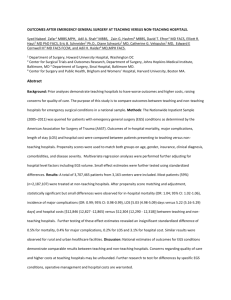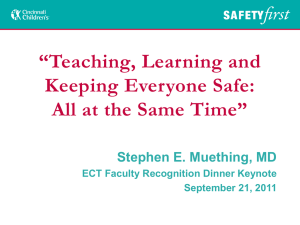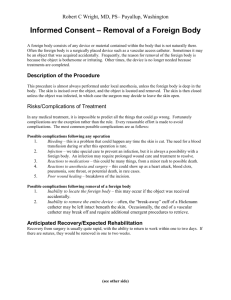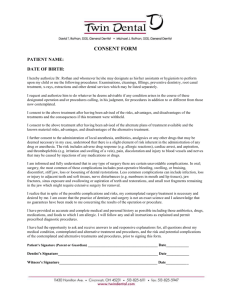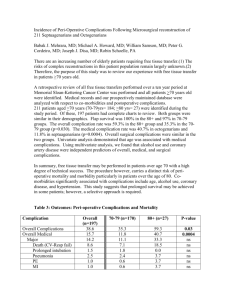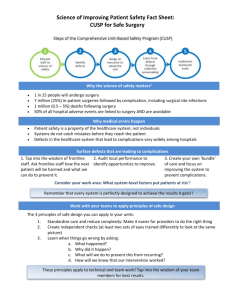The Challenge of Clinical Integration
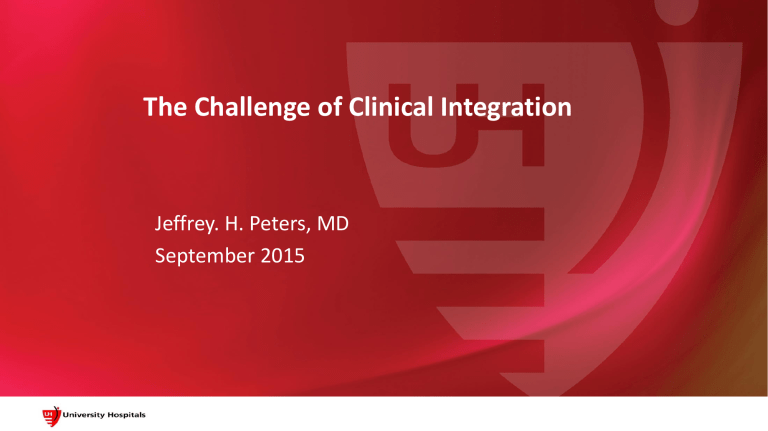
The Challenge of Clinical Integration
Jeffrey. H. Peters, MD
September 2015
Quality
Safety
Healthcare Systems
Clinical Integration
Institutes
High Reliability
Medicine
UH Organizational Profile
Large, Diverse Integrated Delivery System
• Founded in 1866, 149 yrs of service
• $3.7 billion annual operating net revenue
• 25,000 Employees
• 1,752 registered beds
• 18 Hospitals in NE Ohio, 35 Major Outpatient Centers
• 923,081 Unique Patients Seen/yr
• 2,927 UH Providers, 1,576 Independent & Affiliated Providers
• ~ 129,500 Discharges
• 83,929 Surgeries
Opportunities & Challenges
• Systemwide Quality
• New Paradigms
• Institute deployment
• High reliability Medicine
• The example of OB Care
• Variability
Atul Gawande
Hospital Consolidation
US Farming Industry 1950-2000
Grocery Industry
• By 2009, the top four food retailers
Wal-Mart, Kroger, Costco and
Supervalue controlled more than half of all grocery sales.
• largest 100 metropolitan areas, the four largest food retailers controlled 72% of sales by 1998.
Key Principles for Health System
Integration
1. Comprehensive Services across the continuum of care
2. Patient focus
3. Geographic coverage & Access
4. Standardized care delivery through multidisciplinary teams
5. Performance management
6. Information systems
7. Organizational culture & leadership
8. Physician integration
9. Governance structure
10. Financial integration
Big Med – Atul Gawande
“The theory this county is about to test is that chains will make us better and more efficient. The question is how. To most of us who work in healthcare, throwing a bunch of administrators and accountants into the mix seems unlikely to help.
Good medicine cant be reduced to a recipe.
Then again neither can good food; every dish requires attention to detail and individual adjustments that require human judgment.”
New Yorker Aug 13, 2012
The UH Difference
Integrates 7 Centers of Excellence to deliver unparalleled support for sustainable improvement and innovation in care delivery:
Center for Performance
Improvement
Center for Patient
Experience
Center for Quality
Education
Center for Clinical
Informatics
Center for Clinical
Risk/Harm Prevention
Center for Quality
Research
Center for Quality Care in Nursing
UH Quality Institute
Year over Year improvement in:
• Mortality Index
• Core Measures
• Patient Safety Indicators
• Hospital Acquired Infections
• Readmissions
• Measurable Improvement in Value
(Quality/Cost)
• Patient Satisfaction
Confidential Quality Assurance/Peer Review Privileged Pursuant to Ohio Revised Code Sections 2305.24, 2305.25, .251, .252, .253
Mortality, Hospitalizations, and Expenditures for the Medicare Population Aged 65 Years or
Older, 1999-2013
JAMA. 2015;314(4):355-365. doi:10.1001/jama.2015.8035
UH Center for High
Reliability Medicine
“The journey to provide safe, evidence based and effective care that drives out unnecessary variation and creates value”
High Reliability Heath Care; Getting
There from Here
“As opposed to preoccupation with avoiding failure, hospitals and other health care organizations behave as if they accept failure as an inevitable feature of their daily work.”
MR Chassin & JM Loeb. 2013; Joint Commission
UH CLABSI 2014-2015
Confidential Quality Assurance/Peer Review Privileged Pursuant to Ohio Revised Code Sections 2305.24, 2305.25, .251, .252, .253
An Intervention to reduce Catheter Related blood Stream
Infections in the ICU (n=103)
Pronovost P et al. N Engl J Med 2006;355:2725-2732
Pronovost et al. NEJM 2006; 355:
RBC July 2008 – July 2015
Big Med – Atul Gawande
“ In medicine too we are trying to deliver a range of service to millions of people at a reasonable cost and with a consistent level of quality. Unlike the Cheesecake Factory, we haven't figured out how. Our costs are soaring, the service is typically mediocre, and the quality unreliable. Every clinician has his or her own way of doing things, and the rates of failure and complication (not to mention costs) for a given service routinely vary by a factor of 2-3, even within the same hospital.
New Yorker Aug 13, 2012
VARIABILITY
Colon Surgery – Length of Stay by Surgeon
14,00
12,00
10,00
8,00
6,00
4,00
2,00
0,00
DR A DR B DR C
Top 6 Surgeons by volume for UHCMC
DR D DR E
Source: University Healthsystems Consortium, Year 2014, MS-DRG 330
Confidential Quality Assurance/Peer Review Privileged Pursuant to Ohio Revised Code Sections 2305.24, 2305.25, .251, .252, .253
Confidential Quality Assurance Peer Review Privileged Pursuant to O.R.C. Sections 2305.24, 2305.25, 2305.251, 2305.252 and 2305.253
DR F
30
Serum lactate testing:
Bundle utilization variation by point-of-entry care pathway
Emergency Department admissions compared to other acute admission pathways:
100%
90%
80%
74%
73%
69%
86%
80%
71%
70%
60%
66%
64%
59%
68%
60% 56% 55%
50%
51%
44%
40%
32%
30%
30%
17%
20%
10%
0%
Case
Medical
Bedford Conneaut Geauga
ED Admit
Geneva Richmond St. Johns
Admitted Other Pathway System Utilization
Ahuja Parma
Peer Utilization
45%
36%
Elyria
Case
Medical
ED Admit 640
Other Pathway 834
Total Case Count
Bedford Conneaut Geauga Geneva Richmond St. Johns Ahuja
157
45
65
23
336
149
59
13
337
61
628
47
538
246
Parma Elyria
673
80
619
66
© 2015 PREMIER, INC.
The NEW ENGLAND JOURNAL of MEDICINE
SPECIAL ARTICLE
Variation in Hospital Mortality Associated with Inpatient Surgery
Amir A. Ghaferi, M.D., John D. Birkmeyer, M.D., and Justin B. Dimick, M.D., M.P.H.
From the Michigan
Surgical Collaborative for Outcomes Research and Evaluation, the
Department of Surgery,
University of Michigan,
Ann Arbor. Address reprint requests to Dr. Ghaferi at
Michigan Surgical
Collaborative for
Outcomes Research and
Evaluation, 211 N. Fourth
Ave., Suite 201, Ann
Arbor, MI 48104, or at aghaferi@umich.edu ...
N Engl J Med 2009;
361:1368-75.
ABSTRACT
Background
Hospital mortality that is associated with inpatient surgery varies widely. Reducing rates of postoperative complications, the current focus of payers and regulators, may be one approach to reducing mortality. However, effective management of complications once they have occurred may be equally important.
Methods
We studied 84,730 patients who had undergone inpatient general and vascular surgery from 2005 through 2007, using data from the American College of
Surgeons National Surgical Quality Improvement Program. We first ranked hospitals according to their risk-adjusted overall rate of death and divided them into five groups. For hospitals in each overall mortality quintile, we then assessed the incidence of overall and major complications and the rate of death among patients with major complications.
Rates of All Complications, Major Complications, and
Death After Major Complications, According to Hospital
Quintile of Mortality
Ghaferi, A., et al., N Engl J Med 2009;361:1368-1400
Variation in Hospital Mortality Associated with Inpatient Surgery
Although rates of death for patients who underwent inpatient surgery varied by a factor of nearly two (3.5% to 6.9%) across in postoperative complications. Specifically, high- and low-mortality hospitals had nearly identical rates of postoperative complications.
Ghaferi, A., et al., N Engl J Med 2009;361:1368-1400
Variation in Hospital Mortality Associated with Inpatient Surgery
“Although the value of avoiding complications in the first place is obvious, our findings also suggest that improving the care that patients receive once complications have occurred is crucial for reducing.” pg. 1373
Ghaferi, A., et al., N Engl J Med 2009;361:1368-1400
Patient Story
71 y/o with history of HTN, transplant patient (immunosuppressed) with neurosurgical issues, hospitalized multiple times in the last 2 months at different hospitals. Admitted with increased weakness/lethargy after previously returning to normal neurological status admitted for possible neurosurgical intervention. On day 3 of admission…
• 0900: T = 37.3, HR = 103 , RR = 20 , BP = 96/63 (baseline 130’s systolic)
• 1500: T = 36.9, HR = 73, RR = 16, BP = 91/56
• 2045: T = 39.9
, HR = 103 , BP = 70/40
– Temps: 39.2 38.2 38.2
– BP’s: 70/40 500cc bolus ordered --112/86
– RN notes dark urine with output <100c -- repeat 64/42 500cc bolus given
– Repeat BP -70’s systolic no further action taken – deferred to day team
– No lactate drawn, blood cultures drawn
Septic Shock broad spectrum antibiotics = ~12 hours
Current state of Sepsis at UH-CMC
• Current state of Sepsis at UH-CMC
– AVERAGE time recognition as SIRS positive to Sepsis diagnose/treat =
18 hours
– Variation in recognition time: 10hrs 2 days
*by chart review, excludes ICU, Mac and Peds
Intelligence through UHCare
• Physician
Notification
• CDI Prompt
Quality
• SIRS Alert Pilot
• Sepsis Order Set
• VTE assessment
• Smart Peds meds
• Antimicrobial rationalization
Analytics Efficiency
• Dashboards
• Care Guides
HRM Waves
Wave concept
– DRG Groupings
– Prioritized (strategic, financial, leadership, system)
– 16 week focus followed by implementation
– Steady state mgmt.
– Disciplined tracking of outcome metrics
A Sea Change in Treating Heart Attacks
Improvements 2003-2013
• Death rate down 38%
• 2007 - AHA goal of Rx within 90 mins
• Median time in US now 61 mins
• Medicare generated national database of times
• Re-engineered care - In field EKG
Kolata G. New York Times – June 19, 2015
20 Current
Harrington
HVI Sites
Lake
Ashtabula
Cuyahoga Geauga
Portage
• Harrington HVI Programs now at Elyria and Parma
• Harrington HVI Programs planned at Portage & Ashland
Results: D2B Quality Improvement
120
100
99
80
60
40
Door-to-Balloon Time (median, min)
81
Pre-hospital
ECG transmission
70
65
CMC GMC AMC
63
80
54
49
86
64
HHVI-GMC
PCI Lead
70
59
51
57
50
61
20
0
2007 2008 2009 2010 2011 2012 2013 2014
2011: Ahuja opens, Geauga PCI without surgery onsite
ACC/AHA 90 min
Best Practice 60 min
Big Med – Atul Gawande
“ But the “casual dining sector” as it is known, plays a central role in the ecosystem of eating,…..The ideas start out in elite, upscale restaurants in major cities. You could think of them as research restaurants, akin to research hospitals. Then the casual dining chains re-engineer them for affordable delivery to millions. Does health care need something like this?”
New Yorker Aug 13, 2012
System Hospital OB Care, Volume/2014
(Maternal Level of Care, 1 - 4)
• UHCMC (MacDonald) 4,508 (4)
• Geauga (GMC) 1,115 (2)
• Elyria (EMH) 876 (2)
• St John (SJMC) 828 (2)
• Robinson (RMH) 680 (2)
• Parma (PMC) 448 (2)
Guiding principles
• Establish system-wide care paths for labor induction, fetal monitoring, and conduct of labor modified from MAC for community hospital setting.
• Team-oriented strategies lead to decreased communication errors and a positive work environment
• Changes in culture embraced from within each institution by their own champions
• 15 system wide “requirements” for delivering OB care in UH hospitals
• Objective metric of outcomes – serious safety occurrence measured system wide.
To Heal. To Teach. To Discover.
QUESTIONS?
